Upper School End-of-the-Year Trip: Boston
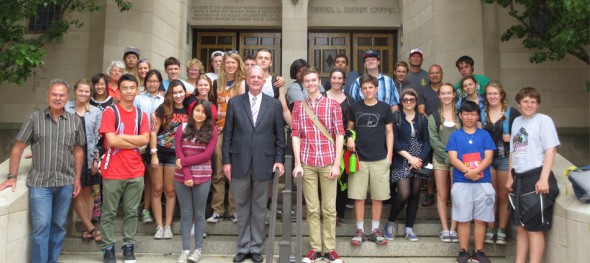
Upper School students met with Reverend Dr. Robert Allan Hill at Boston University. Dr. Hill addressed his role in the university community following the tragic events at the 2013 Boston Marathon.
June 7-11, 2014
Teachers: Bryan Anderson, Megan Nesland, Paula Campanelli, Hugo Macario, Levi Maaia, and Gordon and Suzie Sichi
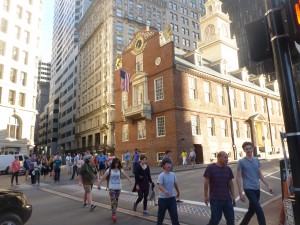 Saturday, June 7, 2014
Saturday, June 7, 2014
Students and teachers arrived on campus promptly at 2:45 AM for a 3:00 AM bus departure for LAX. After stopping in Ventura to pick up two students, the bus made it to the airport in plenty of time for our 7:05 AM departure. The flight went well, and upon our arrival at Logan Airport, Levi Maaia met us to escort us to our hostel. We took the free Silver Line service to the South Station and then walked for 20 minutes to the new Hosteling International facility in an historic commercial building on Stuart Street in the Theater District.
Students quickly checked in to their rooms on the fourth floor and reassembled for our first outing in Boston—dinner at the food court in Quincy Market. Along the way, we walked by the nearby Boston Common and passed Old South Meeting Hall, the Old Statehouse, and Faneuil Hall. The scene there on a summer Saturday evening was lively with the street performers in full force. After meeting up after dinner and checking that everyone in our teacher-led walking groups was present, we headed over to the historic North End, which is now a lively Italian neighborhood. Students had an hour of free time to explore the North End as long as they were not alone. We met up on time at the Paul Revere equestrian statue in Paul Revere Park with the spire of Old North Church towering above. Everyone was pretty tired and ready for bed, so we walked back to the hostel, arriving there by 10:00 PM.
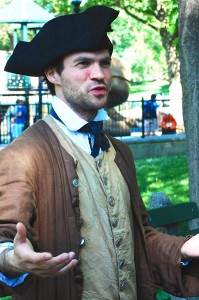 Sunday, June 8, 2014
Sunday, June 8, 2014
Levi Maaia left early to pick up three students who had taken a “red-eye flight” from LAX after taking the SAT in Santa Barbara on Saturday. All arrived safely, and at 8:45 AM, we all took off to meet our guide for the Freedom Trail walk. Our guide, provided by the Freedom Trail Foundation, was a re-enactor playing the role of Robert Newman. The sextant of Old North Church, Newman was the person who placed the two lanterns in the church steeple to alert the Minutemen that the British were coming to Concord by sea, not by land. Dressed in period clothing, our “Robert Newman” did an incredible job of explaining the role Boston played in the events leading up to the American Revolution, especially those that transpired at the Boston Common.
By prior request, our guide put special emphasis on African-American history in Boston and shared many stories of the plight of slaves and freemen during that era. We stopped by the monument to honor the all-black 54th Massachusetts Voluntary Infantry Regiment, which is in front of the Massachusetts Statehouse, and heard the heroic story of the sacrifice made by the regiment and their leader, Robert Gould Shaw. We also learned about Thomas Bulfinch, the famous architect of the Statehouse, and the history of its architecture and the stunning gold dome. Our guide gave special recognition to John Adams and his role in drafting the Massachusetts State Constitution. Other sites we visited on our guided tour were the King’s Chapel Burying Ground, the Old Statehouse, and Faneuil Hall.
After our tour ended at 11:45 AM, we raced back to Old South Meeting Hall to hear Paul Revere’s bell ring. We barely heard it, however, as a Boston Fire Department truck was stopped nearby and drowned out the sounds of the ancient bell. We then began our scheduled tour of Old South Meeting Hall, site of the events that led directly to the 1773 Boston Tea Party. After a short walk to the North End, our next stop was a tour of Paul Revere’s home, the oldest home in Boston.
Afterward, students and teachers had an hour of free time to have lunch in the North End and were expected to meet after lunch in front of Old North Church at 1:30 PM. Everyone showed up on time, and we headed along the Freedom Trail to the Bunker Hill Monument on Breed’s Hill and climbed all the way up inside to the top of the enormous stone obelisk built in honor of the sacrifices made at the Battle of Bunker Hill. Our next stop was the U.S.S. Constitution, the oldest battleship in the world. Along the walk to “Old Ironsides” (as the battleship is called), we enjoyed ice cream bought from Jimmy, the local ice cream man. Students and teachers wandered up and down the ship, which had just recently cruised Boston Harbor.
For our journey back to the hostel, we took a water ferry back to the City and then walked along the beautiful Rose Kennedy Walkway, which just a few years ago was an ugly elevated freeway that was replaced by the Big Dig’s tunnels, which are now located below the Parkway. For dinner that night, we went to the nearby German-American restaurant, Jacob Werth, which has been a restaurant since 1858. Students and teachers then caught up on their sleep after such a big day in Boston.
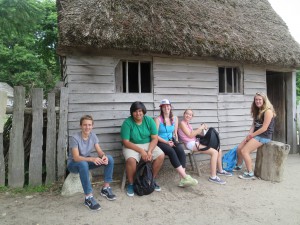 Monday, June 9, 2014
Monday, June 9, 2014
After a good breakfast in our own private dining room in the hostel, students met to take off on the bus trip to Plimoth Plantation. After the 45-minute ride south, we visited the Mayflower II, built by hand in England in the early 1950’s and sailed over as a gift from England to the United States as a thank you for the tremendous war effort we made as a nation to save the world from Nazi domination. The students had a wonderful opportunity for an exclusive meeting with the ship’s re-enactor captain, who dramatically told the story of his experience as the Mayflower’s captain, using the language and dress of the times. He told the story in his captain’s quarters with the students all crammed in around him, and he was a very convincing and authentic re-enactor.
Afterward, we went to the Plimoth Plantation for a tour of the Wampanoag Village with Native American re-enactors and then to the restored 17th century village with its period re-enactors, who talked in the language of the time about their experiences in the early years of colonization. We concluded our time there at lunchtime with a Thanksgiving Dinner with all of the fixings in our own private dining room.
Then, it was off to the John Adams houses in Quincy. We first visited the two old farmhouses, where John Adams and his son, John Quincy Adams, were born and where John Adams had his first law office and also wrote the Massachusetts State Constitution, which still governs the state. Then, we traveled across Quincy to the large home John and Abigail Adams bought after the Revolutionary War. This was a truly amazing experience, as the home and nearby granite library are filled with the original furnishings from generations of Adams family members. The surrounding gardens and tree plantings were even planted by the Adams family! The whole experience gives visitors an intimate connection with the Adams family, who collectively made huge contributions to United States history. After the very informative visit, everyone sat on the green grass under the big Black Oak in a light breeze and shared individually the ways the tour had helped connect each one of us to such a prominent family.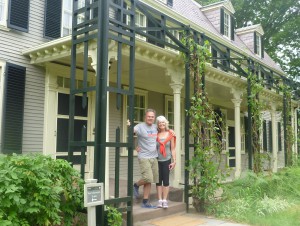
The bus driver drove back to Boston and dropped us off at Copley Square, so we could see the finish line of the Boston Marathon, where the bombings of 2013 took place. Everyone walked back to the hostel with their established walking groups. Dinner that night was at the Empire Garden in Chinatown. Anacapa senior Allen Zhang, an international student from China, had worked out the eight-course menu the day before, handling everything in Chinese.
Tuesday, June 10, 2014
After the usual breakfast, students were very timely in exiting the hostel for our scheduled campus tour of Boston University at 8:45 AM. We took the T subway system for the first time and did very well. At BU, students and teachers were broken up into two groups and were led by student guides, who took us on a tour of the campus, including a typical dorm room. After the hour-long tour was over, we met the Dean of the Marsh Chapel, Reverend Robert Allen Hill, who very graciously agreed to meet us to talk about his religious work at BU. His Sunday services are broadcast worldwide on the Internet, and he is a noted religious leader. He shared some details about Marsh Chapel itself, John Wesley and Methodism, the “Big Questions,” and the various colleges the Methodists have founded across the United States. He also shared information about his own career as a teacher of theology at various colleges. Asked about the loss of one of his students as a result of the Boston Marathon bombing, Bob (as he prefers to be called) grew very emotional in telling the story of that day and the services held afterward for her family. The experience of meeting Reverend Robert Allen Hill was a great opportunity to continue and conclude this year’s Religion Synthesis Unit.
After our Marsh Chapel experience, we had lunch in the BU Student Union, which had a lot of good food choices in a very attractive setting. After lunch, we walked to nearby Fenway Park stadium, built in 1912, for a special educational tour about the history of Fenway Park. We learned about all of the periods of Red Sox history at Fenway, sat on the Green Monster, toured inside the Press Box, and saw the inner workings that fans don’t see when they come to games.
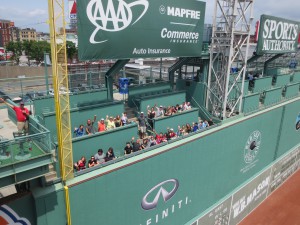 After our tour of Fenway, we met our chartered bus and “step-on” guide for a drive out to Lexington and Concord. While sitting on the lawn of Lexington Green, we heard an amazing historical account of April 19, 1775, the day of the “Shot Heard Around the World.” Afterward, we went to a nearby cemetery, where all eight Americans who died in the Battle of Lexington are buried. On the five-mile drive to Concord, our guide told us about the history of the road and its walls and how the National Parks Service is restoring the area to its appearance during the era of the Revolutionary War. It was on this road that the British were ambushed from behind the stone walls and took heavy losses on their way back to Boston after the skirmish at the South Concord Bridge. We made a quick stop at Concord to hear about the story of the skirmish, then drove to Walden Pond to learn about Thoreau and his brief life there, with some students taking a swim in Walden Pond.
After our tour of Fenway, we met our chartered bus and “step-on” guide for a drive out to Lexington and Concord. While sitting on the lawn of Lexington Green, we heard an amazing historical account of April 19, 1775, the day of the “Shot Heard Around the World.” Afterward, we went to a nearby cemetery, where all eight Americans who died in the Battle of Lexington are buried. On the five-mile drive to Concord, our guide told us about the history of the road and its walls and how the National Parks Service is restoring the area to its appearance during the era of the Revolutionary War. It was on this road that the British were ambushed from behind the stone walls and took heavy losses on their way back to Boston after the skirmish at the South Concord Bridge. We made a quick stop at Concord to hear about the story of the skirmish, then drove to Walden Pond to learn about Thoreau and his brief life there, with some students taking a swim in Walden Pond.
On our way back, we hit a lot of traffic and had to change our plan to walk to the North End for our last dinner together at Maurizio’s Italian Restaurant. Instead, our bus driver drove us to the restaurant, so we could arrive on time. There we had the entire downstairs room, and we just fit into that cozy space with enough room for Levi’s parents, Bill and Linda Maaia, to join us. Everyone’s spirits were quite high. For appreciations, the seniors presented Gordon with a small Indian drum from Plimoth Plantation for their “Talking Stick” for the traditional Trip Appreciations, in which each student and teacher shared something special they appreciated about the trip. After dinner, the students and teachers spilled out into the adjacent Paul Revere Park for some good cheer before heading back across the city to the hostel for our last night.
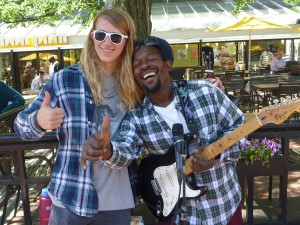 Wednesday, June 11, 2014
Wednesday, June 11, 2014
After breakfast, students and teachers brought down their luggage to be stored until we returned after our outings. We left promptly at7:45 AM for a walk to the Boston Common to see the impressive Civil War-era monument to the men from Boston, who were killed in that war. Then, we walked through the Beacon Hill neighborhood, stopping briefly to see the first school ever built for Free Blacks in Boston. Afterward, we took the T to Harvard University for a short, self-guided tour and then spent some free time in the nearby Harvard Square area to experience the ambiance of Cambridge. Anacapa junior Sam Robertson took out his mandolin to accompany Frankie, a spirited street musician, in some great Reggae songs—”Don’t worry about a thing, because every little thing is going to be all right…..Don’t Worry!” It was a great way to come together on our last day.
Our last stop of the big Boston Trip was the Isabella Stewart Gardner Museum, which is arguably one of the most beautiful and enchanting museums in the world. Isabella Gardner financed and personally supervised the construction of the museum, which is built in the style of a Venetian Palazzo. All of the art was collected by her and arranged exactly the way she wanted it. Not too big, its three floors are filled with hidden gems and masterpieces. It was the perfect final learning experience of our five-day trip.
After the museum, we walked a ways to a T stop, exiting at Boylston Street for the short walk back to get our luggage at the hostel. Then, our last journey in Boston was a walk back to South Station to take the Silver Line to Logan International Airport. The flight back to California went well, and we arrived back on campus at midnight!
Boston strong!
